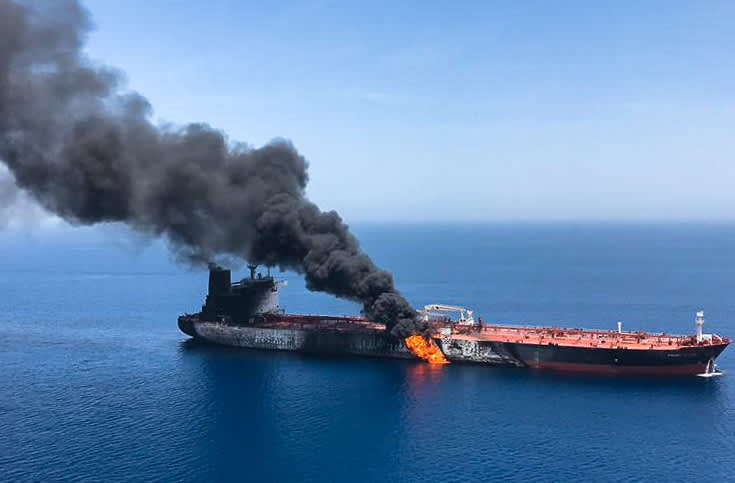Trump administration blames Iran for oil tanker attacks in Middle East
Fire and smoke billow from the Norwegian owned Front Altair tanker, which was said to have been attacked in the Gulf of Oman. ISNA | AF...

Fire and smoke billow from the Norwegian owned Front Altair tanker, which was said to have been attacked in the Gulf of Oman.
ISNA | AFP | Getty Images
WASHINGTON – Secretary of State Mike Pompeo on Thursday blamed Iran for attacks earlier in the day on oil tankers in the Gulf of Oman near Iran and the Strait of Hormuz, a vital shipping route through which much of the world's oil passes.
"Iran is lashing out because the regime wants our successful maximum pressure campaign lifted," Pompeo said without citing specific evidence as to why Tehran was responsible. "No economic sanctions entitle the Islamic Republic to attack innocent civilians, disrupt global oil markets and engage in nuclear blackmail."
"The international community condemns Iran's assault on the freedom of navigation and the targeting of innocent civilians," he said, adding that the U.S. will defend its forces, interests and partners.
Oil prices rose as much as 4% on Thursday on renewed fears of conflict in the Middle East after a series of strikes last month. Crude futures briefly jumped back above 3% after Pompeo accused Tehran of being involved in the latest attacks.
The White House said President Donald Trump was briefed on the matter and blamed Tehran for being behind a similar attack on May 12 on four tankers in the same area. Trump wrote in a tweet Thursday that "it is too soon to even think about making a deal" with Iran, saying that "they are not ready, and neither are we!"
Meanwhile, the Pentagon said in a statement that the U.S. Navy's 5th Fleet received two separate distress calls from the oil tankers shortly after the attacks.
"USS Bainbridge was operating in the vicinity and provided immediate assistance to the M/V Kokuka Courageous. Twenty-one mariners from the M/V Kokuka Courageous, who abandoned ship, are currently aboard USS Bainbridge. A Navy P-8 is also providing support," wrote Lt. Col. Earl Brown, spokesman for the U.S. Central Command, in a statement.
Last month, the Pentagon announced it was sending additional U.S. troops, drones and fighter jets to the Middle East amid increasing tensions between the Washington and Tehran. Officials at the Pentagon said they had credible intelligence that Iran and its proxies are planning to attack American forces in Iraq.
"The deployment will include approximately 1,500 U.S. military personnel and consist of a Patriot battalion to defend against missile threats, additional intelligence, surveillance, and reconnaissance aircraft, an engineer element to provide force protection improvements throughout the region and a fighter aircraft squadron to provide additional deterrence and depth to our aviation response options," acting Secretary of Defense Pat Shanahan wrote in a May 24 statement.
The Nimitz-class aircraft carrier USS Abraham Lincoln transits the Indian Ocean.
Chief Mass Communication Specialist Eric Powell | US Navy
The movement of additional U.S. forces to the region is the Trump administration's latest effort to pressure Tehran over its support for weapons proliferation and extremist groups in the Middle East.
Last month, Trump ordered new sanctions placed on Iranian metals, Tehran's largest non-petroleum-related source of export revenue. The U.S. also took aim at Iranian oil by effectively ordering countries worldwide to stop buying Tehran's crude or face sanctions of their own.
Additionally, the U.S. designated Iran's Revolutionary Guard as a terrorist group. Iran responded with threats to close the Strait of Hormuz, where about a third of the world's oil export vessels pass. The U.S. then announced it was expediting the deployment of a carrier strike group equipped with bomber aircraft to the region.
Tehran announced it was relaxing some restrictions on its nuclear program but would not violate a 2015 accord with Russia, China, Britain, France, Germany and the United States. Iran had agreed to the 2015 limits on its disputed nuclear program in return for sanctions relief.
A year ago Trump withdrew the U.S. from the Joint Comprehensive Plan of Action, calling it a "horrible, one-sided" deal.
Read More